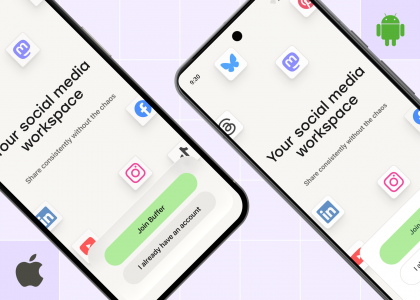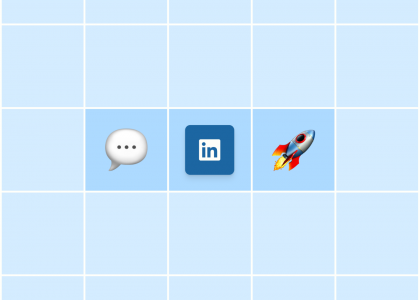In my 20s, I fell down a health and fitness rabbit hole. Well, not so much ‘fell’ as hurtled head first, banged my head a bit, and didn’t emerge until a good few years later.
It did mean I went through a very intense period of saying no to dessert (would not recommend), but it also helped me fall in love with exercise (would recommend) — and almost accidentally, build something of a personal brand.
At one point, I’d started a fitness blog, landed a great job as a writer at Women’s Health Magazine, and dabbled in personal training. As a result, I built up a 6,000-strong following on Instagram.
But by my late 20s, my obsession with health and fitness had cooled to a much more balanced hobby — which was around the same time I moved into content marketing.
I still posted occasionally on Instagram, but since it was no longer my job to create content in the realm of the brand I’d built, my following and engagement waned. I wasn’t too bothered — until I warmed to the idea of cultivating a professional personal brand in content marketing to level up my career.
Creating content for Buffer has left me perfectly positioned to do so, and I’ve been actively posting on LinkedIn for a few months. I’ve also taken over as the host of a podcast on marketing, and I wanted to leverage other channels to promote it, too.
I realized it was time for a personal brand pivot. Could I flip the switch on my previously smoothie-filled feed on Instagram? Or would it be best to write that audience off completely?
Naturally, I put it to the experts. I called on a group of top-notch personal brand aficionados to see what they’d recommend — and asked them to offer some more general advice on how to pivot a personal brand, too.
Meet the experts
Adrienne Sheares, Social PR Expert, Principal Digital Strategist @ ViviMae LabsChristine Gritmon, Personal Brand Consultant @ Christine Gritmon Inc.Ghalib Hassam, Account Manager @ KurogoKasey Jones, Growth Strategy Coach & Consultant, Co-Founder & Strategist @ Power Your PlatformJack Appleby, Social Media & Creator Consultant, Creator of Future Social newsletterManam Iqbal, Personal Brand Expert & Partner @ 1115 Inc
When to pivot your personal brand
How do you know when to take the plunge? There are two major reasons it could be time to shift gears on your personal brand:
Your efforts aren’t yielding the results you want.You’re just not enjoying cultivating your brand anymore.
Even if only one applies, it’s a good enough reason to change direction. Given that both of these things were pretty true for me, my decision was reaffirmed.
Adrienne Sheares, a Social PR Expert, shared an interesting personal anecdote on #1. When she launched the thought leadership and personal branding part of her social media consultancy business, none of her leads matched her new offering. They were all traditional social media pros rather than people who needed personal branding guidance.
“I wasn’t surprised by that because that’s what people have known about me for over ten years,” she said. “I knew I needed to pivot so it could be clear to my audience and prospects about my new direction and so that the leads could be aligned with my newest venture. You know it’s time to pivot when your current brand no longer serves your current needs. Everything needs to be aligned.”
For personal brand consultant Christine Gritmon, a lack of enthusiasm for the personal brand you’ve cultivated is the dealbreaker. “For me, it’s about excitement,” she told me. “Am I geeking out on what I’m doing, or does it feel like a chore? Do I feel aligned with what I’m putting out there as ‘me,’ or has it started to feel like a role I’m playing?”
Jack Appleby, a Social Media and Creator Consultant, feels similarly. He didn’t mince words, either: “Personal brands are personal — nothing’s more important than loving the brand and content you’re building. You should pivot when you personally want to pivot.”
How to pivot your personal brand
You’ve made the call to switch — congrats! Now, the real work begins. After pooling all the advice I received from my experts, these are the steps I’m taking to pivot my personal brand:
Pinpoint what wasn’t working
If you’ve pulled on the threads above, you likely have a good idea of the ‘why’ behind your move. Now, unravel them completely. What wasn’t working about your old brand, specifically?
For me, the primary issue was that my heart was no longer in creating fitness content. I mostly enjoyed it, but it was a bit of a slog I didn’t have time for. Plus, it didn’t serve me professionally anymore.
To pinpoint what wasn’t working: the ability to create content in that niche regularly was no longer achievable. When I was a health and fitness journalist, I was already creating that content as part of my job, so having interesting insights to share on social didn’t require much additional work. But now, I didn’t have that huge bank of content to lean on. My output had dramatically decreased, and my audience was shrinking. My followers were losing interest and moving on.
Fortunately, my career — and personal brand shift — are the solution here. The new audience I want to reach (ambitious content writers and marketers) are who I’m creating for in my role, and I have a wealth of content I can tap into for sharing on social once more. It’s great knowing that I can lean into a similar approach that helped me build a brand in the past, even if it’s in a completely different area.
Follow other creators in your new field
I loved this advice from personal brand expert Manam Iqbal — she recommended “studying” other creators within your industry and noting several things: “their topics, frequency, styles, formats, hooks, and closing statements.”
If their content is already performing well in your niche, it goes without saying that you can learn a thing or two from them. Of course, you’re only looking for inspiration here, not a blueprint.
“The next step is to start using what you’ve learned within your content and test it out for a few weeks,” Manam says. But make sure you put your own spin on things, she added.
“People are not interested in vanilla content that looks and sounds like everybody else’s (or worse, content copied and pasted from ChatGPT). This is the most common mistake people make with their personal brands.”
Start with a plan
It’s time for more introspection. Somewhat counterintuitively, it’s best to start at the end. In other words, decide on your ultimate goal.
“Figure out what you want to get out of your personal brand,” Ghalib Hassam, Account Manager at personal brand agency Kurogo, said. “Once you know what the end goal looks like, it’s time to reflect all that in your content and outreach strategy.”
When it comes to building that strategy, Power Your Platform founder Kasey Jones has a really handy framework of questions to answer to help you flesh it out:
Why do you want to grow online? Not just “get leads” or “make more money.” Go deeper. What is important about this work? How is it connected to the vision you have for your future? What problems can you help you solve? What content will you share? What do you want to be known for? Who are you speaking to? This is your ideal customers, dream employers, or even younger you. How will you differentiate? How will you be authentically you online? Is it your style of writing? Your word choice? The stories you tell? The energy you bring? The way you make people feel?
Some good news from Adrienne on this front: “Your plan doesn’t have to be complicated or long. I like to create an outline with this information, no longer than a page. I regularly refer back to it to make sure my social posts, conference talks, podcast interviews, etc. are aligned.”
Thankfully, I’d already done a lot of the groundwork for this plan when I wrote an article about growing my following on LinkedIn. I won’t bore you with my entire outline, but here’s the gist of it:
My goal is to become an industry thought leader, and ultimately future-proof my career. I’ll be sharing content for ambitious content writers and marketers looking to level up, both in terms of their actual work and climbing the career ladder (or landing at a company like Buffer).
Consider whether or not you should create new social media accounts
This is something I’ve really struggled with. Do I deactivate my old Instagram account and create a new one to tie in with the personal brand I’ve already started building on LinkedIn?
The response from experts on whether or not to start all over on the various social platforms was a resounding: “Probably not.” Honestly, this was a relief — I’m rather attached to @itsmekirsti.
“If your social media account is your name, I wouldn’t start anew in most cases,” Adrienne said. “I would just start the process of pivoting. Depending on my goals, I would determine if I need to delete old content that isn’t aligned. But for most of us, there’s a common theme that follows us with pivots.”
Ghalib made a great point on this, too. “If you already have a presence, I don’t recommend creating new accounts. If you have a network, there’s a chance that there’ll be some spill, and some people from your old network can be leveraged for your pivot.” (Health-nut marketers, I see you!)
“But, if you don’t have a significant presence and a non-leverageable network, then it’s better to start from scratch, he added. Another important point from Ghalib: if you don’t have a presence on a platform frequented by your target audience, then definitely spin up accounts and get creating on there. “LinkedIn, Facebook, Instagram — wherever your ICP [ideal customer profile] is, you should be there too.”
According to Jack, though, a big pivot meant a strong case for spinning up new profiles. “If you’re making a hard shift into a new category, there’s a lot of validity to making new social accounts. When I started documenting my adult basketball journey, I made a brand new TikTok for it — I didn’t think my existing audience would be interested.”
Identify common threads between your old brand and new one
There’s a good chance of overlap between your old personal brand and your new one: whether that’s a specific segment of your audience, a common theme, or even learnings about your content that you can take along with you.
Christine often works with career-switching clients, and has made personal brand pivots big and small throughout her own career. In all cases, she reminds her clients (and herself) that this never really means starting from zero. “I always want to build somehow on the brand equity I’ve already built, so I look at the common factors that will help bridge the trust from the old brand to the revised one,” she said.
Ask yourself what appealed most to people about your old personal brand, she suggested. “Did they primarily see you as a health and fitness expert, or did they primarily see you as a writer whose work they enjoyed? Either way, I’d certainly give people a chance to come along with you on this journey into marketing; there are definitely people interested in both, as well as people who trust you and will simply let you educate them about marketing even if they weren’t interested before.”
This was super helpful to me — and I’m sure there is a chunk of my audience who do follow Kirsti, the writer, rather than Kirsti, the personal trainer. Plus, a bit of health and wellness content might be well-received by the new audience I’m looking to reach. Marketers need to stay healthy to be productive, right?
“It’s not off-brand to still toss something about your activities and interests in there now and then,” Christine said. “If it’s still genuinely on-brand for you as a human, who cares if you’re not writing about it anymore?”
Notify your audience (if you want)
Should you let your audience know that you’re changing directions? This is another question with an answer in the “it depends” camp.
“On social media, an announcement can be a nice inflection point for your personal branding campaign,” Adrienne suggests. “And it doesn’t have to be one-and-done. Since organic reach on social media is limited, plan on reiterating the change several times as most people won’t see the announcement.”
Kasey took a more pragmatic approach. “Most of the time your audience won’t really notice or care. We tend to think that others care about what we do far more than they actually do.”
Given the fact that I know my audience is certainly not eagerly awaiting my next post about deadlifts — it had been months since I shared anything of real value on Instagram — I thought I was safely in the “they probably won’t notice” camp.
Still, I added a little postscript to one of my new posts on Instagram:”P.S. I’m pivoting a little from the kind of content I previously created here in the hope of being a little more authentic. If content on #socialmedia, #personalbranding, #contentmarketing, #productivity, and #remotework (with a sprinkling of fitness and motherhood) is not your vibe, please hit unfollow. I won’t be mad. 😅”
Start slowly — and be realistic about the numbers
If you’re sticking with your old social media accounts, you’ll want to build up slowly. Manam, Kasey, and Adrienne all advocated for a period of experimentation as you get the hang of catering to a different audience. “Consistent, little steps eventually make a big impact,” Adrienne said.
Another pro tip: don’t let the desire to make a colossal splash keep you from making any changes at all. “You don’t have to wait until the perfect moment,” Adrienne said. “I find the pressure to make a big flip keeps too many people on the sidelines or stuck in a direction that no longer serves them.
As you begin to share more content aligned with your new brand, it’s unrealistic to expect stellar results right out of the gate. Kasey warns that you’ll probably go through a period of losing followers — and that’s OK. “Don’t chase them. Stick to your guns, and the right audience will stick around and then be attracted to what you’re doing.”
Manam suggests considering moderate success a win and leaning into content like this. “What were some of your best performers after making the above changes? What did they have in common? Which posts totally flopped? What were the common underlying causes?”
Having already started building my personal brand 2.0 on LinkedIn, I plan to repurpose this content and share it with my Instagram audience — slowly. When writing this, I had published a handful of 2.0 posts on Instagram with mixed results.
This Instagram Reel about how to become a Top Voice on LinkedIn — a huge departure from my old content — got a not-too-shabby 1,600 views. That’s a far cry from my top-performing Reel (23,000 views on, er, squats), but I’m taking the win.
Don’t overthink it
Sure, there’s a lot to consider when it comes to pivoting — but don’t let the fear of changing lanes keep you tied to an inauthentic personal brand.
“We overthink the details of our own transformations so much, and when it comes down to it, the impact on our audiences may be totally subconscious,” Christine said. “All that matters is that they still recognize and trust us.”
With that in mind, there’s really no perfect way to shift your brand. I’ll leave you with another great quote from Jack: “There’s no wrong answer because it’s your account.”






